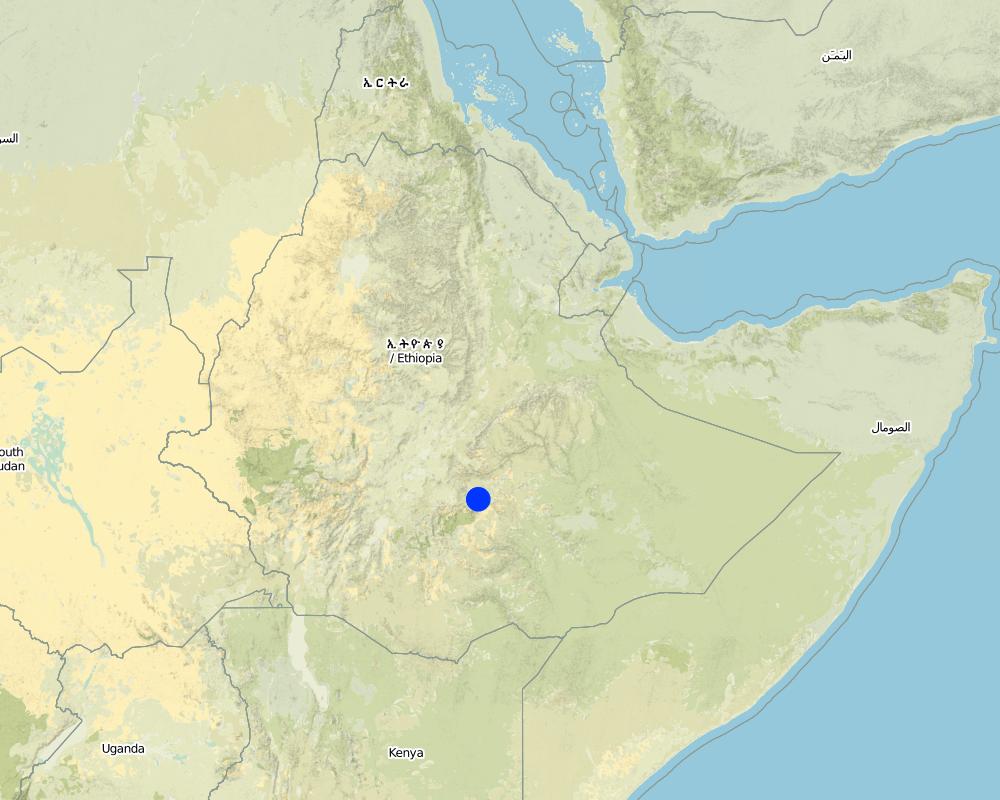Local Level participatory planning approach (LLPPA) [埃塞俄比亚]
- 创建:
- 更新:
- 编制者: Philippe Zahner
- 编辑者: –
- 审查者: Fabian Ottiger
approaches_2675 - 埃塞俄比亚
查看章节
全部展开 全部收起1. 一般信息
1.2 参与方法评估和文件编制的资源人员和机构的联系方式
有助于对方法进行记录/评估的机构名称(如相关)
Swiss Agency for Development and Cooperation (DEZA / COSUDE / DDC / SDC) - 瑞士1.3 关于使用通过WOCAT记录的数据的条件
编制者和关键资源人员接受有关使用通过WOCAT记录数据的条件。:
是
1.4 SLM技术问卷的参考

Stablized Stone Faced Soil Bund [埃塞俄比亚]
Stablized bund constructed fron stone and soils on the farm land along the contour and planted with multipurposive plant species
- 编制者: Unknown User
2. SLM方法的描述
2.1 该方法的简要说明
Participatory planning tools using various PRA techniques to enable the local community to identif their problem prioritize to sellect suitable measures & activities (planing, implementing & mgt of conservation based initiatives.
2.2 该方法的详细说明
该方法的详细说明:
Aims / objectives: Aims at the sellection of suitable measures & activities in line with the problems needs of the community & individuals relating to soil & water conservation, To develop (enable) the community to involve (participate) fully inplaning, implementing, monitoring managing of conservation based initiatives and decision making, Aims at the selection of suitable measures and activities in line with the problem and needs of the community and individuals, Hence promotion of productivity of the project areas to address the problems, Employ a wide range of methods facilitate community participation in planning discustion on subject area (suitation), i.e. general discustion with community, Group and indvidual discussion community meeting, consulting., Identify targeted areas, initial meeting with community leaders, adminstrators 1st meeting with community. Form (sellect) development team., Problem identification prioritize sellect suitable measures & activities work plan pre paration, planning implementing, monitoring evaluation., Identify the major problems, prioritize identification sellection of proposed development, measures. Work plan preparation, Implementation of sellected activities.
2.5 采用该方法的国家/地区/地点
国家:
埃塞俄比亚
区域/州/省:
Oromiya
Map
×2.6 该方法的开始和终止日期
注明开始年份:
1992
2.7 方法的类型
- 基于项目/方案
2.8 该方法的主要目的/目标
The Approach focused mainly on SLM with other activities (Micro credit schems, forest development, water development, development of infrastructure.)
The SLM Approach addressed the following problems: Erosion problem (Soil and Water), Food shortage problem, Infrastructure problems, Production problems.
2.9 推动或妨碍实施本办法所适用的技术的条件
社会/文化/宗教规范和价值观
- 阻碍
Need external inputs, Lack of responsibility to keep & maintain
Treatment through the SLM Approach: Provide training, encourage the participation of community in all activities.
财务资源和服务的可用性/可得性
- 阻碍
Poverity; less production yield, shortage of farmland, increasing of family size
Treatment through the SLM Approach: Apply income generating projects, intensfy family planning programme, improve local farming system, effective management.
机构设置
- 阻碍
Less finanical capacity & skilled man power, lack of well & highly organized institue
Treatment through the SLM Approach: Encourage the involvement of different NGO's strengthen their capacity.
了解SLM,获得技术支持
- 阻碍
Lack of skilled manpower, ignoring of indigenous k/dge; less technical awareness of farmers.
Treatment through the SLM Approach: Capacity building, community training, encourage (modify) indigenous k/dge.
3. 相关利益相关者的参与和角色
3.1 该方法涉及的利益相关者及其职责
- 当地土地使用者/当地社区
Specific ethnic groups: Locally existing groups
Because of the local cultural norms cultural barriers. Mainly men be a team leader, and excutives. Group 1 & group 2 By ranking their wealth & using vulnearability ranking & the sellected criteria of land size & live stock holding.
- 国家政府(规划者、决策者)
Regional state, W/resource dev. Authority MOA.
- 国际组织
3.2 当地土地使用者/当地社区参与该方法的不同阶段
| 当地土地使用者/当地社区的参与 | 指定参与人员并描述活动 | |
|---|---|---|
| 启动/动机 | 被动 | consuling; Participate by consulting involved by answering question area. |
| 计划 | 互动 | Mainly: rapid/participatory rural appraisal, public meetings; partly: workshops/seminars, interviews/questionnaires; Planning prepared by Devt. Team descussed with communities. |
| 实施 | 外部支持 | casual labour, responsibility for minor steps; Participatte by his labour & contribute equipment (materials) |
| 监测/评估 | 被动 | Mainly: interviews/questionnaires, public meetings; partly: measurements/observations; Involved by answering questions |
| Research | 无 |
3.4 有关SLM技术选择的决策
具体说明谁有权决定选择要实施的技术:
- 主要是土地使用者,由SLM专家提供支持
解释:
Land users sellect the suitable measures of activities facilitated by SWC specialists.
Decisions on the method of implementing the SLM Technology were made by mainly by SLM specialists with consultation of land users
5. 融资和外部物质支持
5.1 该方法中SLM组成部分的年度预算
注释(例如主要的资助来源/主要捐助者):
Approach costs were met by the following donors: international non-government (-): 100.0%
7. 参考和链接
7.1 方法/信息来源
- 实地考察、实地调查
- 与土地使用者的访谈
链接和模块
全部展开 全部收起链接

Stablized Stone Faced Soil Bund [埃塞俄比亚]
Stablized bund constructed fron stone and soils on the farm land along the contour and planted with multipurposive plant species
- 编制者: Unknown User
模块
无模块


